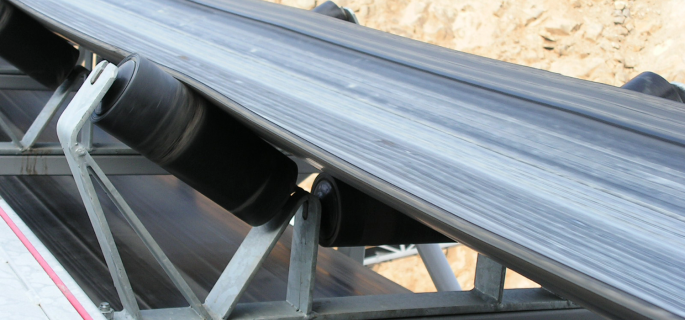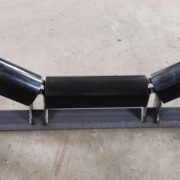Conveyor Side Guide Rollers in Conveyor Systems
Conveyor systems play a pivotal role across various industries, from manufacturing to logistics, by facilitating the smooth transport of goods and materials. These systems are integral to production efficiency and cost-effectiveness, making their maintenance crucial for operational success. A key component in ensuring the longevity and efficiency of these systems is the use of conveyor side guide rollers. Innovative designs ensure conveyor belt alignment with durable conveyor side guide rollers, minimizing side-slip and optimizing integration and performance.These rollers are essential for maintaining precise belt alignment, preventing slippage, and reducing wear and tear on the conveyor belt. Understanding the function and importance of conveyor side guide rollers is vital for any industry that relies on conveyor systems to prevent downtime and extend the life of the equipment.
Types of Conveyor Side Guide Rollers
Conveyor side guide rollers come in various types, each designed to meet specific operational needs across different industries. Understanding these variations is essential for optimizing the conveyor system’s efficiency and durability.
Heavy-Duty Conveyor Side Guide Rollers
Heavy-duty conveyor side guide rollers are built to withstand extreme conditions and loads, making them ideal for applications in industries such as mining, quarrying, and other bulk material handling environments.
- Mining Operations: Used to handle the abrasive and heavy loads of mined materials.
- Quarrying: Essential for transporting large stone slabs and other heavy quarry products.
- Steel Manufacturing: Suitable for handling heavy and hot steel products in mills.
- Recycling Facilities: Durable enough to manage heavy and unpredictable waste materials.
- Agriculture: Used in bulk handling of grains and other agricultural products.
These rollers are designed to endure more wear and tear than standard rollers and often feature reinforced structures and specialized materials to extend their lifespan under harsh conditions.
Variety of Conveyor Belt Roller Types
The functionality of conveyor systems can be greatly enhanced by selecting the appropriate type of conveyor belt rollers. Here is a table that outlines the different types of conveyor belt rollers and their functionalities:
| Roller Type | Material Used | Functionality |
|---|---|---|
| Standard Steel Rollers | Steel | General purpose roller, durable under normal conditions |
| Plastic Rollers | Polymer materials | Lightweight, corrosion-resistant, suitable for food industries |
| Impact Rollers | Rubber-coated steel | Absorb shock at loading points, reducing belt damage |
| Motorized Rollers | Steel with motor units | Drive the conveyor belt, enhancing control over speed and flow |
| Retractable Rollers | Steel or plastic | Allow sections of the belt to be lifted for maintenance or sorting purposes |
Each type is tailored to specific environmental and operational demands, enhancing the system’s overall effectiveness.
Introduction to Side Roller Guides and Other Components
In addition to the rollers themselves, conveyor side guide systems include several other components like side roller guides, roller guide rails, guide roller wheels, and guide roller assemblies. These elements work together to enhance the guiding function of the rollers:
- Side Roller Guides: These are mounted along the sides of the conveyor to ensure lateral stability of the belt.
- Roller Guide Rails: Typically installed parallel to the belt, these provide a fixed track for the rollers to follow, enhancing precision.
- Guide Roller Wheels: Positioned at critical points, these wheels help maneuver the belt around corners or through tight spaces.
- Guide Roller Assemblies: Comprising multiple rollers and support structures, these assemblies are used in more complex systems where additional belt control is necessary.
Together, these components form an integral part of conveyor side guide systems, contributing to the efficient and smooth operation of conveyor belts in diverse settings.
The Specification of Conveyor Side Guide Rollers
The specifications of conveyor side guide rollers can vary depending on the application and the type of conveyor system. However, some common specifications and features to consider include:
Material
- Steel: Durable and suitable for heavy-duty applications.
- Stainless Steel: Corrosion-resistant, ideal for food processing and pharmaceutical industries.
- Plastic (Polyurethane, Nylon): Lightweight, corrosion-resistant, and suitable for lighter applications or where noise reduction is important.
Dimensions
- Diameter: Typically ranges from 50mm to 200mm, depending on the conveyor belt size and load requirements.
- Length: Varies according to the width of the conveyor belt and the specific installation requirements.
- Shaft Diameter: Should match the mounting requirements of the conveyor system.
Bearing Type
- Sealed Bearings: Protects against dust and moisture, ensuring longevity and smooth operation.
- Open Bearings: Easier to maintain but more susceptible to environmental contaminants.
Mounting Style
- Fixed: Provides stable guidance in applications where the belt direction does not change.
- Adjustable: Allows for fine-tuning of the roller position to accommodate different belt widths or alignment requirements.
Load Capacity
- Light-Duty: Suitable for smaller, lighter loads.
- Heavy-Duty: Designed to handle larger, heavier loads, ensuring robustness and durability.
Surface Finish
- Smooth: Reduces friction and wear on the conveyor belt.
- Textured: Provides additional grip, useful in applications where belt slippage is a concern.
Environmental Considerations
- Temperature Resistance: Depending on the operating environment, rollers may need to withstand extreme temperatures, either high or low.
- Chemical Resistance: Important in applications involving exposure to chemicals or harsh cleaning agents.
Compliance
- Industry Standards: Ensure that the rollers comply with relevant industry standards and regulations, such as those from OSHA or other regulatory bodies.
By carefully selecting the right specifications for conveyor side guide rollers, businesses can ensure efficient, safe, and reliable operation of their conveyor systems.
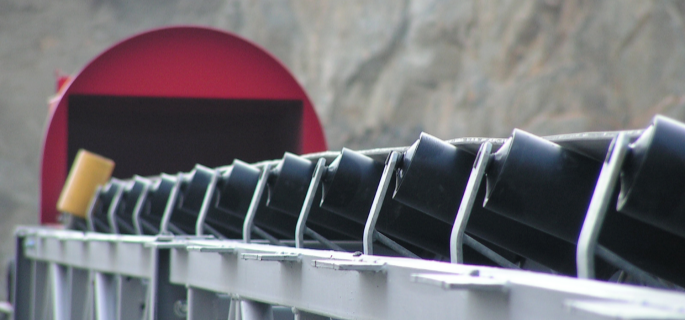
Best Conveyor Side Guide Rollers
When it comes to optimizing the performance of conveyor systems, selecting the best conveyor side guide rollers is crucial. These rollers must be tailored to specific industrial applications and environments to ensure they deliver the highest efficiency and longest service life. Below are key factors and qualities to consider when choosing the best conveyor side guide rollers for various settings.
Factors to Consider
Selecting the right conveyor side guide rollers involves considering multiple aspects that impact their performance and suitability for different applications:
- Load Capacity: Rollers must support the weight of conveyed materials without deforming or failing. In heavy-duty industries like mining, choosing rollers with high load capacity is essential.
- Operating Environment: For environments with high moisture or corrosive materials, such as chemical processing plants, rollers made from corrosion-resistant materials are necessary.
- Speed Requirements: High-speed applications, like packaging lines, require rollers that can handle high rotational speeds without generating excessive heat or noise.
- Maintenance Needs: In industries where downtime is costly, such as automotive manufacturing, selecting rollers that require minimal maintenance can significantly reduce operating costs.
- Size and Fit: Proper sizing and fit within the conveyor system are critical to prevent misalignment and ensure smooth operation.
Qualities of the Best Conveyor Side Guide Rollers
The best conveyor side guide rollers are defined by several key qualities that ensure their effectiveness and reliability across different conveyor types:
- Durability: Rollers should be built to withstand the operational demands and environmental conditions they will face. For example, rollers used in outdoor applications should be able to resist weather-related wear and tear.
- Material Quality: High-quality materials like reinforced polymers or treated metals can enhance the lifespan and performance of the rollers. Rollers used in the food industry often use FDA-approved materials.
- Compatibility: The best rollers are those that are compatible with various types of conveyor systems, ensuring a seamless fit and operation. This is crucial for facilities that use multiple types of conveyors.
- Design Efficiency: Well-designed rollers reduce the energy consumption of the conveyor system by minimizing friction and resistance. This is particularly important in sectors where energy efficiency is a priority, such as in green manufacturing.
- Innovative Features: Features like self-lubricating bearings or vibration-dampening cores can make a significant difference in applications that require high precision or where noise reduction is critical.
By carefully considering these factors and qualities, businesses can select the best conveyor side guide rollers that not only meet their specific needs but also contribute to the overall efficiency and longevity of their conveyor systems.

The Role of Conveyor Side Guide Rollers
Conveyor side guide rollers are critical components that serve multiple functions in the operation of conveyor systems. Primarily, these rollers work by guiding the conveyor belt and ensuring it travels in a consistent path without deviation, which is crucial for the longevity and efficiency of the entire system. By maintaining the alignment of the belt, side guide roller conveyor prevent the belt edges from fraying and the belt from slipping off the rollers, which can lead to significant downtime and repair costs.
The significance of preventing belt misalignment cannot be overstated, as it directly impacts the performance and reliability of conveyor systems. Misalignment can cause uneven belt wear, increased energy consumption, and can stress the conveyor structure itself.
- Packaging Industry: In high-speed packaging lines, conveyor side guide rollers ensure that products are aligned properly before they reach the packing area, reducing jams and mispackaging.
- Mining: Conveyor side guide rollers in mining operations prevent belt misalignment which is crucial in harsh environments where dust and debris can lead to frequent disruptions.
- Food Processing: In the food industry, these rollers help maintain hygiene by minimizing the belt’s contact with potentially contaminating surfaces and by ensuring smooth operations.
- Airport Baggage Handling: Effective use of conveyor side guide rollers ensures that baggage is routed correctly through various checkpoints, avoiding misroutes and delays.
- Manufacturing: For assembly lines, maintaining belt alignment with conveyor side guide rollers is essential to ensure that components reach their assembly points without interruption.
In all these scenarios, conveyor side guide rollers play an essential role in enhancing system performance by ensuring consistent and reliable movement of materials, thereby optimizing operational efficiency and reducing maintenance needs.
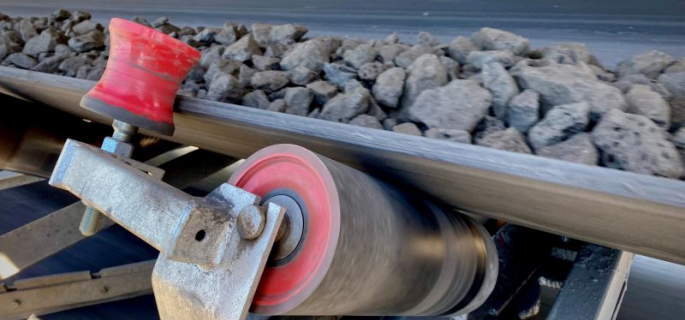
The Importance of Conveyor Side Guide Rollers
Conveyor side guide rollers are an essential component of conveyor systems. Their importance can be highlighted in several key areas:
Guidance and Alignment
- Maintaining Conveyor Belt Alignment: Side guide rollers help in keeping the conveyor belt centered, preventing it from drifting to the sides. This is crucial for the efficient operation of the conveyor system.
- Reducing Wear and Tear: Proper alignment reduces the wear and tear on the edges of the belt, prolonging its lifespan.
Safety
- Preventing Spillage: By keeping the belt aligned, side guide rollers help in preventing materials from spilling off the sides, which can create hazards and lead to product loss.
- Minimizing Risks: Properly aligned belts reduce the risk of accidents caused by belt slippage or misalignment, enhancing overall workplace safety.
Operational Efficiency
- Smooth Operation: Side guide rollers ensure the smooth operation of the conveyor by preventing the belt from wandering. This leads to consistent and efficient material handling.
- Reducing Downtime: By preventing misalignment, they reduce the likelihood of breakdowns and the
Featured Products: PPI Conveyor Side Guide Rollers
PPI (Precision Pulley & Idler) is a renowned leader in the design and manufacture of high-quality conveyor components, including their exceptional range of conveyor side guide rollers. These guide rollers are specifically engineered to enhance conveyor system efficiency and longevity. Here, we explore the distinctive features of PPI guide rollers and how they excel in terms of quality, design, and versatility across various applications.
Features of PPI Guide Rollers
PPI guide rollers are designed with precision and built using advanced materials and manufacturing techniques to ensure maximum performance and durability. Some of their key features include:
- Robust Construction: Made with heavy-duty materials, these rollers can withstand harsh environments and heavy loads, making them suitable for industries like mining and aggregate processing.
- Low Maintenance Design: PPI guide rollers are designed to require minimal maintenance, featuring sealed bearings that reduce the need for regular lubrication.
- High Precision: Precision engineering ensures that these rollers operate with minimal vibration and noise, which is crucial for operations in sensitive environments.
- Energy Efficiency: The smooth and efficient design of PPI guide rollers reduces drag on the conveyor belt, lowering energy consumption.
- Safety Features: Safety is enhanced with features that prevent the accumulation of materials on the rollers, reducing the risk of system malfunctions and downtime.
How PPI Guide Rollers Stand Out
PPI guide rollers are distinguished not just by their construction but also by their application versatility and innovative design.
- Bulk Material Handling: In industries where bulk materials are processed, such as cement production or coal handling, PPI guide rollers provide the durability and robustness needed to handle large volumes of heavy materials without frequent replacement.
- Food Processing: For the food industry, PPI offers guide rollers that are made from FDA-approved materials, ensuring safety and compliance with industry standards.
- Logistics and Warehousing: PPI guide rollers are ideal for the high-speed requirements of sorting systems and conveyors used in distribution centers, improving throughput and reducing bottlenecks.
- Pharmaceuticals: In the pharmaceutical industry, where cleanliness and precision are paramount, PPI’s smooth and reliable guide rollers ensure that conveyor systems operate without contamination.
- Agriculture: PPI guide rollers are used in agricultural equipment for handling and processing grain and other products, where their durability and efficiency ensure that operations run smoothly during critical harvest times.
Through these examples, it’s evident that PPI conveyor side guide rollers are not only built to last but are also tailored to meet the specific needs of various i
Guide Roller Assembly and Maintenance of Conveyor Side Guide Rollers
Proper assembly and maintenance of side guide roller conveyor are crucial for ensuring optimal performance and extending the lifespan of conveyor systems. This section provides a detailed guide on the assembly process and offers practical maintenance tips.
Assembly of Conveyor Side Guide Rollers
Assembling conveyor side guide rollers involves a few precise steps to ensure they are installed correctly and function efficiently. Here’s a step-by-step guide:
- Preparation: Gather all necessary tools and parts. Ensure the conveyor area is clean and safe to work in.
- Positioning: Place the roller brackets along the conveyor frame at predetermined intervals. These intervals are crucial for maintaining proper belt alignment.
- Mounting Rollers: Secure the rollers into the brackets. Make sure they are evenly spaced and parallel to each other to ensure smooth operation.
- Alignment Check: Verify the alignment of the rollers with the conveyor belt. Adjust as necessary to prevent any lateral movement of the belt.
- Final Inspection: Conduct a thorough inspection to ensure all components are securely fastened and the rollers move freely without obstruction.
Maintenance Tips for Conveyor Side Guide Rollers
Maintaining conveyor side guide rollers effectively can significantly enhance their functionality and durability.
- Regular Cleaning: Keep the rollers and surrounding areas free from debris and buildup, which can cause the rollers to jam or the belt to misalign.
- Lubrication: Periodically lubricate the bearings and other moving parts of the rollers, if applicable, to reduce friction and wear.
- Inspection Schedule: Implement a regular inspection schedule to check for wear and tear, cracks, or misalignments in the rollers and the conveyor belt.
- Immediate Repairs: Address any issues identified during inspections immediately to prevent further damage and potential downtime.
- Replacement Planning: Keep track of the lifespan of each plan and roller for replacements before failures occur. This proactive approach helps in avoiding unexpected disruptions in conveyor operations.
By following these guidelines for assembly and adhering to proactive maintenance practices, you can ensure that your conveyor side guide rollers operate efficiently and last longer, contributing to the overall reliability and productivity of your conveyor system.
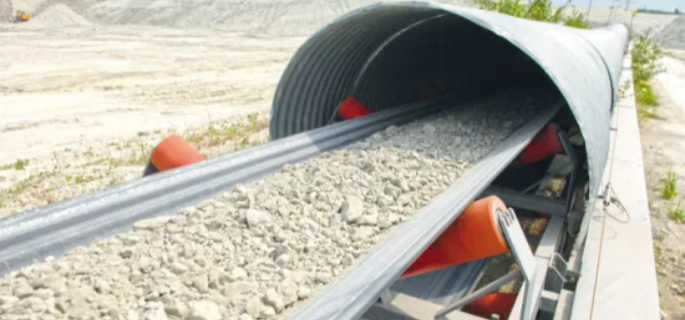
Real-world Applications of Conveyor Side Guide Rollers
The utility of conveyor side guide rollers extends across multiple industries, each benefiting from the enhanced efficiency and safety these components provide. This section explores the varied applications of side guide roller conveyor and presents case studies to illustrate their effectiveness in real-world settings.
Industries Benefiting from Conveyor Side Guide Rollers
- Automotive Manufacturing: Conveyor side guide rollers are used extensively in the automotive industry to move parts along assembly lines precisely and efficiently, ensuring that each component reaches its destination without deviation.
- Food and Beverage Processing: In this industry, conveyor side guide rollers help maintain the cleanliness and order of production lines, essential for compliance with strict hygiene standards.
- Pharmaceuticals: Here, rollers ensure that sensitive materials move through the production process under controlled conditions, preventing contamination and ensuring consistent product quality.
- Packaging: In packaging facilities, these rollers adjust the movement of goods from one stage to another, ensuring that products are aligned correctly for packaging and labeling.
- Mining and Minerals Processing: The robust design of conveyor side guide rollers makes them ideal for the heavy-duty demands of mining operations, where they help transport ore and other materials efficiently from mines to processing facilities.
Case Studies Demonstrating the Effectiveness of Conveyor Side Guide Rollers
- Automotive Assembly Plant: A major car manufacturer reported a 20% increase in assembly line speed after upgrading to high-performance conveyor side guide rollers, which reduced belt misalignment and associated downtime.
- Food Processing Facility: A biscuit manufacturer highlighted improvements in production line reliability after installing food-grade stainless steel guide rollers, significantly reducing contamination risks and maintenance costs.
- Pharmaceutical Packaging Line: A pharmaceutical company showcased a case where enhanced precision in their conveyor setups, aided by specialized guide rollers, improved the accuracy of bottle filling and capping, thereby increasing throughput and reducing waste.
- Distribution Center: A logistics company provided a testimonial on their use of motorized guide rollers, which improved the sorting accuracy and speed of their conveyor systems, enhancing overall operational efficiency.
- Mining Operation: A case study from a mining operation illustrated how durable conveyor side guide rollers adapted to harsh environments helped decrease conveyor belt replacements and maintenance costs by 30%.
These real-world examples and case studies underline the crucial role that high-quality conveyor side guide rollers play in enhancing the efficiency and functionality of conveyor systems across diverse industries. By ensuring smooth, accurate, and reliable belt movement, these rollers are instrumental in improving the overall productivity and cost-effectiveness of production and material handling processes.
Contact us to find the perfect conveyor roller for your needs.
FAQs About Conveyor Side Guide Rollers
Guide rollers for conveyor belts are specialized components designed to keep conveyor belts aligned and moving smoothly along the conveyor system. These rollers are mounted on the sides of the conveyor frame and are essential in preventing the belt from slipping off the tracks, which could lead to operational disruptions and damage to the belt. The primary function of guide rollers is to ensure that the conveyor belt follows a consistent path without lateral movement, thereby maintaining the efficiency and longevity of the conveyor system. They play a crucial role in industries where precision and reliability are paramount, such as in packaging, manufacturing, and material handling operations. By reducing friction and wear on the conveyor belt, guide rollers contribute significantly to the overall health and productivity of the conveyor system.
A guide roller is a specific type of roller designed to control the direction and position of conveyor belts, cables, or other flexible materials as they move through a conveyor system or similar setup. These rollers are typically mounted along the sides of a conveyor system and may be adjustable to accommodate various belt widths and ensure proper alignment. The design of a guide roller may vary depending on its specific application, but it generally includes a cylindrical body that can rotate freely, often with bearings to minimize friction. The materials used in manufacturing guide rollers can range from metals for heavy-duty applications to plastics and rubbers for specific environmental or product handling needs. The effectiveness of guide rollers is critical in minimizing wear and extending the service life of conveyor belts.
Conveyors utilize various types of rollers based on the application, load requirements, and environmental conditions. Common types of conveyor rollers include:
Drive Rollers: Motorized and provide the driving force to move the conveyor belt forward.
Idler Rollers: Freely rotating and support the conveyor belt along its length.
Impact Rollers: Located at loading zones to absorb the shocks and stresses imparted as materials are loaded onto the conveyor.
Return Rollers: Support the return path of the belt, usually after the material has been offloaded.
Guide Rollers: Ensure that the conveyor belt does not stray from its intended path.
Each type of roller plays a crucial role in the operation of a conveyor system, and the choice of roller can significantly affect the efficiency and durability of the system.
Roller conveyors are categorized based on their functionality and the type of operations they support. The primary types include:
Gravity Roller Conveyors: Utilize the force of gravity to move products along the conveyor; ideal for light to medium load applications.
Powered Roller Conveyors: Use electric motors to move the conveyor rollers and are suitable for heavier loads or controlled movement.
Flexible Roller Conveyors: Designed to be adjustable and can be curved, folded, or manipulated to fit various spaces and applications.
Accumulating Roller Conveyors: Allow products to accumulate on the conveyor without pressure between them, using either a belt under the rollers or by individually powered rollers.
Each type serves different industrial needs, from simple material transfer to complex production lines, highlighting the versatility of roller conveyors in various applications.
Conveyor rollers work by supporting and moving the conveyor belt, which carries materials along the system. These rollers are positioned in a series along the length of the conveyor and are typically set in a frame. As the belt moves, the rollers rotate, minimizing friction and allowing the belt to move smoothly. Drive rollers, connected to a motor, provide the necessary power to move the belt, while idler rollers support the belt and ensure proper tension. Side guide rollers keep the belt aligned, preventing it from drifting off track. The rolling action of these components reduces wear and tear on the belt, facilitates the efficient movement of goods, and ensures the system operates reliably. Overall, conveyor rollers are crucial for maintaining the functionality and efficiency of conveyor systems across various industries.
Jordan Smith, a seasoned professional with over 20 years of experience in the conveyor system industry. Jordan’s expertise lies in providing comprehensive solutions for conveyor rollers, belts, and accessories, catering to a wide range of industrial needs. From initial design and configuration to installation and meticulous troubleshooting, Jordan is adept at handling all aspects of conveyor system management. Whether you’re looking to upgrade your production line with efficient conveyor belts, require custom conveyor rollers for specific operations, or need expert advice on selecting the right conveyor accessories for your facility, Jordan is your reliable consultant. For any inquiries or assistance with conveyor system optimization, Jordan is available to share his wealth of knowledge and experience. Feel free to reach out at any time for professional guidance on all matters related to conveyor rollers, belts, and accessories.

